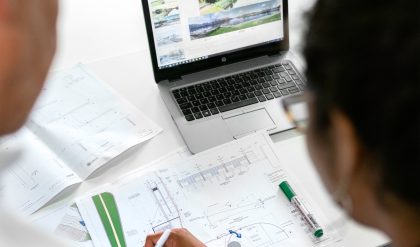You do not need to understand the technology to be able to produce solar power. By utilizing the Solar Energy, we make it simple, safe and profitable to obtain solar energy. If you are still interested in how the technology behind solar cells works, you can read more below.
The electricity produced by solar cells is direct voltage. Therefore, in order to obtain 220/400 volts alternating current, an inverter is used which converts DC voltage to alternating voltage. The inverter that you connect to the house must work with the mains outside the house. Inverters for grid input are specially built to produce their own electricity that is output on the grid and at the same time be able to buy electricity as usual via the grid when the sun does not generate enough energy. The inverter must also immediately disconnect from the mains if there is a power failure.
The position and roof slope of the house affects the output.
The output depends on many factors, one of which is the slope of the roof. The optimal location is to the south with a 30-40 degree roof slope. If you have a facility that is partially shaded by something during the day, it is very important to think about how the panels are connected/sectioned. A good alternative if you have shade and especially when shading from trees is to use optimizers for the exposed panels, or alternatively for the whole plant. The installation cost increases slightly but pays off in the long run.
Where you live also makes a difference
Where you live has a great effect on how much electricity you can generate through your solar panels.
Shading is the biggest enemy of the solar panels and it is important to take into account any shading when calculating. Read more about shading below.
Solar panels or solar cells?
When you talk about solar, you sometimes use both the terms solar panels and solar cells. Strictly linguistic is the correct term for the module that sits on the roof solar panel. The solar panel itself consists of a number of solar cells that are connected to a solar panel.
The majority of solar panels today are approximately 1.0 * 1.65 m in size and weigh just under 20 kg. They usually consist of 60 series-connected silicon solar cells, 15 * 15 cm in size with a glass pane in front and a plastic film behind. See the picture typical structure on the right. There are also panels with 72 cells that are usually slightly higher, about 2 meters.
The glass panel is designed to withstand wind, snow load, and hail. Around the panel is an aluminum frame that is used to attach the panel to the mounting frame. The panels usually have power at full sunlight (1000 W / m²) of 275-300 W and a voltage of about 30-40 V. There are also panels with greater power, but they are usually also physically larger.
The solar panels are connected in series with one another in one or more strings. Typically, a voltage of between 500 – 1000 V is reached. It is this voltage that is introduced to the inverter that converts the direct voltage into an alternating voltage which is what we use in the home.
There are two different materials that are common: single-crystalline (monocrystalline) silicon or multi-crystalline (polycrystalline) silicon. In the past, mono was usually better and more expensive, but today this is not always the case. The biggest differences today are mainly aesthetic and that polycrystalline is often somewhat cheaper. The polycrystalline are often bluish in color, while the monocrystalline are usually either solid black or black with white borders around each cell.
How much surface area is needed?
If you are expecting the most economical, it is advisable to install panels that produce about 75% of the annual requirement (max. 100%). Example: If you consume 20,000 kWh, it is ideal to have about 15,000 kWh of production on the panels. Normally, 50% of the energy produced is used and 50% is output to the grid. Consequently, consumption is reduced by 7,500 kWh to 12,500 kWh and approximately 7,500 kWh is supplied to the grid.
The area per installed kW is determined by the efficiency of the modules. The efficiency of a modern panel is usually around 18% and then the module surface area per kW becomes 1 / 0.18 = 5.55 m2. The fact that this is the simple formula is due to the efficiency stated at a solar radiation of 1000 W / m2.
If the environment is your main motive for installing solar cells, we recommend a maximum number of panels that can be placed on the roof. You can expect a longer payback period, but in the long term an even better investment, as production will be greater while the electricity price will probably increase over the lifetime.
How long do solar cells last?
Practically all solar panels, in addition to the usual warranty against manufacturing defects, also have a power guarantee which usually promises at least 80% production after 25 years, which would probably be quite unique for an electrical product. When we do a profitability calculation, we usually assume 30 years of life on the solar panels. The inverters can be assumed to have a similar service life, although the warranty is usually much shorter.
What is an Inverter?
The inverter performs the task of hacking up and converting the relatively high DC voltage from the solar panels to the same voltage and frequency as the mains. Before the current is fed to the mains, it is filtered to minimize harmonics and thus produce as pure a sine wave as possible. Transformer-free inverters that are most common today and which we mainly supply have very high efficiency. Efficiency is important as a few percent reduction in efficiency can become thousandths after a few years.
Internet
The choice of inverters is also important from the aspect that all makes have different ways of presenting the information on the internet and in apps. The connection is done using Wi-Fi or wired internet (RJ45).
Shading and selection of inverters
In general, the choice of inverters is very important and we, therefore, supply CE marked and well-known makes.
Shade can affect annual production to a large extent. There is no way to completely counter this phenomenon, however, with the help of so-called optimizers, you can reduce the negative effect. The optimizer works so that it adjusts the voltage and current individually for each panel that has the optimizer and thus gives higher energy yield, especially at so-called partial shading. Optimizers can be used for both so-called inverters (most common type) and inverters that require optimizers on all panels (Solaredge).
If you use a Solaredge inverter that becomes slightly more expensive, you also get some other benefits such as panel-level monitoring, longer warranty time and the opportunity to completely break the voltage on the roof.







